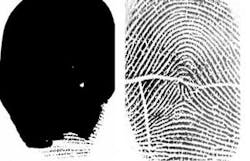HOLOGRAPHIC OPTICAL ELEMENTS: Holographic system improves fingerprint imaging

A biometric fingerprint-capture device introduced by Aprilis (Maynard, MA) capitalizes upon the unique properties of holographic optical elements.1 The HoloSensor allows capture of up to 2×2-in. images at 500 or 1000 dots per inch (dpi) with image quality designed to meet or exceed the FBI’s Integrated Automated Fingerprint Identification Systems (AFIS) Image Quality Specification. The 1000-dpi system is capable of obtaining fingerprint images that provide opportunity for analysis using AFIS Level III detail (ridge-deviation and pore-detail capture), a significant advance for criminal and military identification systems. The use of Level III detail provides significantly higher discrimination and identification analysis than the Level II analysis (bifurcation and termination points of ridges) used by other authentication applications, including some commercial electronic products such as cell-phone and laptop fingerprint-identification pads.
Existing single-finger slap fingerprint readers range in resolution from 200 to 500 dpi. Semiconductor fingerprint sensors, such as arrays of silicon microcapacitor plates that are used in certain cell phones, laptops, and PDAs, tend to be at the lower end of the resolution range. Optical fingerprint sensors, including those used in certain computer peripherals (mouse, keyboard) as well as those used for the United States Visitor and Immigrant Status Indicator Technology (VISIT) and other government programs, tend to have resolutions that are typically at 500 dpi.
Optical fingerprint devices rely upon the principle of total internal reflection (TIR) to achieve high-contrast images. In current optical devices, an array of light-emitting diodes (LEDs) illuminate a volume diffuser plate, thereby homogenizing the light before it passes through a prism face and illuminates a second prism face (platen) on which a candidate’s finger is placed. The geometry of the device is such that the incident light hits the platen at an angle of approximately 45°. When no finger is placed on the platen, the light experiences TIR and reflects off the platen, passing out a third face of the prism where it is imaged onto a CMOS sensor using typically a two- to four-element refractive imaging system. When a finger is placed on the platen, ridges of the fingerprint wet the prism platen, frustrating the TIR effect and allowing light in those regions to transmit and become absorbed by the skin. The high-contrast dark and light regions of the image correspond to ridges and valleys, respectively, of the fingerprint.
The disadvantage of current optical devices is that by capitalizing upon the TIR effect using refractive optics, the object plane (the platen) is tilted relative to the optical axis of the imaging system. The result is distortion and other optical aberrations that must be corrected. If the angle at which light is directed toward the finger is increased to 60° to 70° to prevent the TIR effect from being frustrated by water (due to sweaty fingers), these aberrations become more severe. Although an optical system could be designed to correct these aberrations, vendors have not been able to achieve this goal in the form factor and at the cost the market requires.
Several into one
The Aprilis holographic optical element achieves a more glancing angle of incidence at the platen without introducing the problems of optical distortion that have so far limited systems that use conventional optical designs. The design condenses several optical elements into one compact holographic lens package. As a result, the imagers can read fingerprint features despite having water or sweaty fingers present on the platen (see figure). In addition, the resolution is significantly higher than that of other fingerprint devices currently in use. The 1000-dpi system can identify and match fingerprints using pores. To achieve this performance, Aprilis uses a photopolymer material developed for holographic data-storage applications. Because image quality as well as optical throughput is critical for fingerprint readers, a recording material is required that exhibits low shrinkage (less than 0.1%) and high dynamic range (large refractive-index modulation). Consequently, dichromated gelatin and non-Aprilis photopolymers were not an option.
Performance is further enhanced by the use of green light that is more effectively absorbed by skin than the red light typically used in optical fingerprint readers. “Because Aprilis’ photopolymers are made for the data-storage community, they have gone through rigorous environmental testing,” notes Glenn Horner, vice president of business development. “Aprilis is developing 2000- and 4000-dpi systems that will keep pace with the ever-expanding AFIS standard,” he adds.
REFERENCE
1. Talk by Aprilis for the Boston NES/OSA Chapter, Boston, MA (Jan. 20, 2005).
About the Author

Gail Overton
Senior Editor (2004-2020)
Gail has more than 30 years of engineering, marketing, product management, and editorial experience in the photonics and optical communications industry. Before joining the staff at Laser Focus World in 2004, she held many product management and product marketing roles in the fiber-optics industry, most notably at Hughes (El Segundo, CA), GTE Labs (Waltham, MA), Corning (Corning, NY), Photon Kinetics (Beaverton, OR), and Newport Corporation (Irvine, CA). During her marketing career, Gail published articles in WDM Solutions and Sensors magazine and traveled internationally to conduct product and sales training. Gail received her BS degree in physics, with an emphasis in optics, from San Diego State University in San Diego, CA in May 1986.